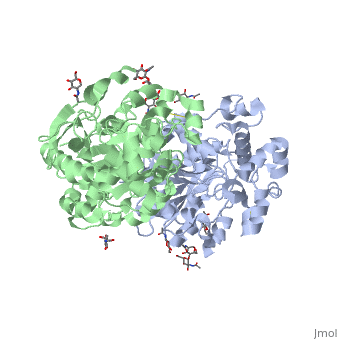Sandbox 78
From Proteopedia
|
Contents |
Introduction
Human gastric lipase (HGL, E.C. 3.1.1.3) (PBD ID: 1hlg) is the lipase that is responsible for initiating the digestion of dietary fats in the stomach [1]. This acid-stable enzyme [2] is secreted by the fundic chief cells of the human stomach and catalyzes 10-20% of total lipolytic processes (i.e., those involving fat breakdown) in healthy adults [1]. HGL specifically catalyzes the hydrolysis of triacylglycerol in order to produce diacylglycerol and a carboxylate byproduct [3], a process that facilitates subsequent fat breakdown by pancreatic lipase [4]. In terms of disease implications, there is evidence to suggest that HGL secretion is altered in individuals with gastritis (the most common gastric condition, in which the stomach lining is inflamed) [2].
Structural highlights
HGL, a dimeric hydrolase enzyme consisting of two 379 amino acid residue-long subunits, possesses a that contains residues Ser-153, His-353, and Asp-324. This structure is essential to the breakdown of lipids, coordinated with an at Leu-67 and Gln-154 [4], that serves to stabilize the transition state. Structurally, the human gastric lipase exhibits a complex (beta sheets shown in yellow, alpha helices shown in orange, coiled coils shown in green, and amino acid side chains shown as purple). The of HGL at residues 215-244 [4] gives way to the (hydrophobic regions noted in red) both surrounding the active site and interfacing the lid. These areas are thought to draw lipids and promote docking [3].
Function

HGL functions at an optimal pH of approximately five, and primarily catalyzes the hydrolysis of short-chain triacylglycerols [6].
As an esterase with a catalytically active serine, HGL exhibits a mechanism resembling the established serine esterase mechanism. The active site serine, located within the , is facilitated first by the neighboring formation of a salt bridge between Asp-136 and His-152, which induces the appropriation of a proton from Ser-153. The now highly nucleophilic Ser-153 will attack the carbonyl carbon of the acetate group in a triacylglycerol molecule. The tetrahedral species is stabilized by the oxyanion hole. However, as soon as the species disassembles into the covalently bonded acetate and lipase, the serine undergoes deacylation in which water acts as the nucleophile. This final step restores Ser-153 to its protonated state [7].
Relevance to Human Health & Disease
Tomasik et al. (2013) [2] investigated the hormonal regulation of HGL secretion in children and adolescents with gastritis. HGL activity was compared across three groups: one experimental group consisting of adolescents diagnosed with Helicobacter pylori gastritis (n = 10), another experimental group consisting of adolescents with a non-H. pylori induced form of gastritis (n = 10), and one control group of healthy adolescents (n = 14). HGL activity, in addition to plasma concentrations of glucagon-like peptide-1, cholecystokinin, and glucose-dependent insulinotropic peptide, were observed through analysis of gastric juice samples that had been collected via endoscopic measurements from each patient.
Patients whose superficial gastritis was induced by pathogens other than H. pylori exhibited lower levels of HGL activity compared to both healthy adolescents (p < .005) and those who were diagnosed with H. pylori gastritis (p < .005). Mean plasma concentrations of glucose-dependent insulinotropic peptide were lower in healthy patients (p < 0.005) than in those with non-H. pylori gastritis (p < .003) and those with H. pylori gastritis (p < 0.01). Regulation of HGL secretion by glucagon-like peptide-1 and cholecystokinin was therefore found to be altered in adolescents with gastritis. In addition, glucose-dependent insulinotropic peptide was found to be a powerful activator of human gastric lipase activity in all experimental and control groups [2].
References
- ↑ 1.0 1.1 Armand M, Hamosh M, DiPalma JS, Gallagher J, Benjamin SB, Philpott JR, Lairon D, Hamosh P. Dietary fat modulates gastric lipase activity in healthy humans. Am J Clin Nutr. 1995 Jul;62(1):74-80. PMID:7598069
- ↑ 2.0 2.1 2.2 2.3 Tomasik PJ, Wedrychowicz A, Rogatko I, Zajac A, Fyderek K, Sztefko K. Gastric lipase secretion in children with gastritis. Nutrients. 2013 Jul 29;5(8):2924-32. doi: 10.3390/nu5082924. PMID:23899880 doi:http://dx.doi.org/10.3390/nu5082924
- ↑ 3.0 3.1 Roussel A, Canaan S, Egloff MP, Riviere M, Dupuis L, Verger R, Cambillau C. Crystal structure of human gastric lipase and model of lysosomal acid lipase, two lipolytic enzymes of medical interest. J Biol Chem. 1999 Jun 11;274(24):16995-7002. PMID:10358049
- ↑ 4.0 4.1 4.2 Selvan A, Seniya C, Chandrasekaran SN, Siddharth N, Anishetty S, Pennathur G. Molecular dynamics simulations of human and dog gastric lipases: insights into domain movements. FEBS Lett. 2010 Nov 19;584(22):4599-605. doi: 10.1016/j.febslet.2010.10.021. Epub, 2010 Oct 20. PMID:20965171 doi:http://dx.doi.org/10.1016/j.febslet.2010.10.021
- ↑ Adapted from [1]; image generated using [2]
- ↑ Gargouri Y, Pieroni G, Riviere C, Sauniere JF, Lowe PA, Sarda L, Verger R. Kinetic assay of human gastric lipase on short- and long-chain triacylglycerol emulsions. Gastroenterology. 1986 Oct;91(4):919-25. PMID:3743968
- ↑ Pfeffer JM, Weadge JT, Clarke AJ. Mechanism of action of Neisseria gonorrhoeae O-acetylpeptidoglycan esterase, an SGNH serine esterase. J Biol Chem. 2013 Jan 25;288(4):2605-13. doi: 10.1074/jbc.M112.436352. Epub 2012 , Dec 3. PMID:23209280 doi:http://dx.doi.org/10.1074/jbc.M112.436352

